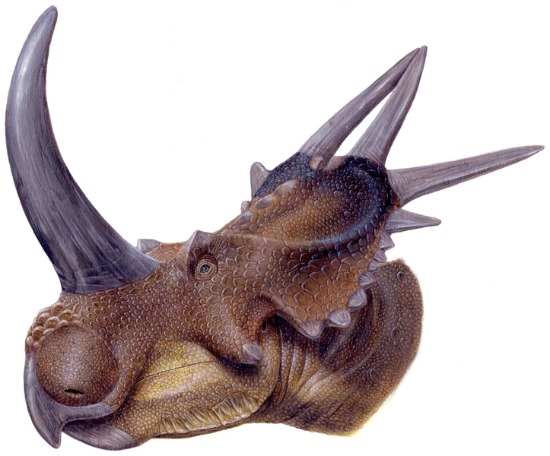The Last Styracosaurus Standing
Within just a few years, three species of Styracosaurus were cut down to just one
/https://tf-cmsv2-smithsonianmag-media.s3.amazonaws.com/filer/20120302115024Styracosaurus-AMNH-thumb.jpg)
One of my favorite dinosaurs at the American Museum of Natural History is the Styracosaurus. The insanely ornamented creature is presented as if swimming through a wave of plaster, a pose meant to depict the way the dinosaur was found in the field. It is a beautiful mount, but the restored and reconstructed skeleton obscures the fact that the actual specimen is not so complete.
Veteran fossil hunter Barnum Brown discovered the Styracosaurus in 1915. He found the fossil within what is now Canada’s Dinosaur Provincial Park. Most of the dinosaur’s post-cranial skeleton was intact, but as Brown later noted in a 1937 paper he wrote with colleague Erich Schlaikjer, only a few parts of the skull were recovered. That lovely skull on the AMNH mount was mostly reconstructed on the hypothesis that the animal was really a Styracosaurus. Brown believed that the few parts which were collected were enough to name a distinct species of this dinosaur: Styracosaurus parksi.
Brown’s new species was the third flavor of Styracosaurus to be named. Paleontologist Lawrence Lambe named the first species, Styracosaurus albertensis, in 1913, and Charles Gilmore followed with Styracosaurus ovatus in 1930. Both were very spiky dinosaurs distinguished by the prominent spikes jutting out of the parietal bones on their frills. But Brown considered his dinosaur to be a separate species on the basis of slight differences in the few skull elements he had collected. The squamosal bone—another frill element—seemed to be longer and different in shape than the animal Lambe had named Styracosaurus albertensis.
Early 20th century paleontologists had a tendency to over-split dinosaurs on the basis of very slight differences. Naming a new genus or species was easy to justify during the early bone rushes. There were so few specimens, and researchers understood so little about how dinosaurs grew up, that variations among individuals or differences attributable to age were often taken as the hallmarks of distinct species. And traits thought to distinguish between dinosaur genera turned out to be less diagnostic than originally thought. Styracosaurus once seemed to be unique in having spiky parietals, for example, but similar features have since been found in closely related centrosaurine dinosaurs such as Achelousaurus, Einiosaurus, Centrosaurus brinkmani, Pachyrhinosaurus and, the new kid on the block, Spinops. In order to sort out Styracosaurus, in 2007 paleontologists Michael Ryan, Robert Holmes and A.P. Russell reviewed the material attributed to this dinosaur.
Ryan, Holmes and Russell counted only two Styracosaurus species as valid: S. albertensis and S. ovatus. Brown’s specimen, while incomplete, fell within the variation documented for S. albertensis, and so S. parksi was sunk. And at the genus level, Ryan and co-authors distinguished Styracosaurus from similar dinosaurs by the anatomy of the ornaments at each slot on the parietal part of the frill. The first ornament is typically a tiny nub, the second either appears as a small tab or hook, the third is a large spike and the fourth is also a large spike. (The remaining ornaments at positions five through seven vary in size and shape between individuals.)
But the Styracosaurus genus was recently winnowed down even further. Most Styracosaurus specimens belonged to the northern species S. albertensis, but the species S. ovatus was represented by a single specimen found in Montana. This significantly extended the range of Styracosaurus, at least until paleontologists Andrew McDonald and Jack Horner suggested in 2010 that the Montana dinosaur really represented a different genus. On the basis of the partial frill and other skull fragments, they named the dinosaur Rubeosaurus. It was another weird horned dinosaur with a huge nasal horn, and the third parietal horns were directed inward, towards each other, rather than outward like in Styracosaurus. Within just a few years, three species of Styracosaurus were cut down to just one.
References:
Brown, B., Schlaikjer, E. 1937. The skeleton of Styracosaurus with the description of a new species. American Museum Novitates. 955, 1-12
Andrew T. McDonald & John R. Horner, (2010). “New Material of “Styracosaurus” ovatus from the Two Medicine Formation of Montana”. Pages 156–168 in: Michael J. Ryan, Brenda J. Chinnery-Allgeier, and David A. Eberth (eds), New Perspectives on Horned Dinosaurs: The Royal Tyrrell Museum Ceratopsian Symposium, Indiana University Press, Bloomington and Indianapolis, IN.
Ryan, M., Holmes, R., Russell, A. (2007). A revision of the late campanian centrosaurine ceratopsid genus Styracosaurus from the Western Interior of North America
Journal of Vertebrate Paleontology, 27 (4), 944-962 DOI: 10.1671/0272-4634(2007)272.0.CO;2
/https://tf-cmsv2-smithsonianmag-media.s3.amazonaws.com/accounts/headshot/RileyBlack.png)

/https://tf-cmsv2-smithsonianmag-media.s3.amazonaws.com/accounts/headshot/RileyBlack.png)